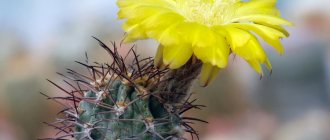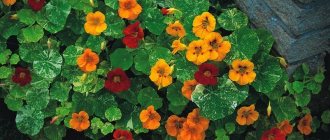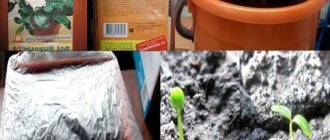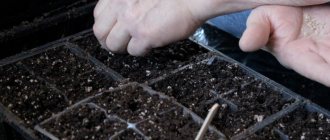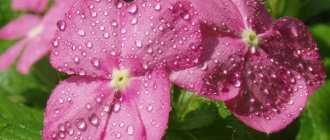Gravilat is a pretty herbaceous perennial that grows wild in the cold and temperate climate zones of our country. It can be found both in the warm Caucasus and in frosty Siberia, where it likes to settle in wooded valleys and often grows near bodies of water (river gravitate). The plant is also ubiquitous on other continents, has many varieties, some of which are very rare, protected from extinction, and can only be seen today in photographs. Planting and caring for gravel in open ground is not difficult when it comes to zoned winter-hardy varieties. And in regions where the thermometer does not fall below -15...-18C, the plant can remain green all year round.
Plant varieties
are known , the most famous are: urban, river, hybrid, Chilean, garden, bright red, forest, creeping, Aleppo.
Each species , in turn, has many varieties, the most popular among them:
- "Red Dragon" (terry gravylate) is distinguished by the presence of large super-double inflorescences. It pleases with abundant flowering during the summer, but begins to bloom only 14 weeks after sowing;
- "Crimson" : its inflorescences have semi-double flowers, blooms in early summer;
- “Fireball” : distinguished by large flowers, reaching 4 cm in diameter. The leaves are lyre-shaped with teeth, they remain green for a long time;
- "Blazing Sunset" : begins to bloom in June, there are many flowers, double inflorescences. Reaches 60 cm;
- "Double Sunrise" : perennial, grows up to 60 cm. Blooms from the end of June, the size of the flowers is small, they are red, in paniculate inflorescences;
- "Cosmopolitan" : perennial, reaches 40 cm. Large semi-double flowers have a cream color and pink edging;
- "Mrs Bradshaw" : perennial, characterized by abundant flowering for a long time. Flowering begins the next year after planting, the flowers are fiery red, semi-double;
- "Mai Tai" is distinguished by single flowers collected in paniculate or corymbose inflorescences. Blooms from June to September.
Growing and care
Gravilat is a fairly hardy, unpretentious plant. But it is worth creating certain conditions for its growth. You can choose a variety that will suit the conditions of your region. Recommended care for gravilate includes basic measures: watering, fertilizing with organic fertilizers in small doses, and constantly removing faded flowers.
Watering and fertilizing
Gravilat definitely needs constant soil moisture. Especially in the first year after planting, the plant should be watered regularly once a week, unless it rains. Every subsequent year in the summer, it is worth monitoring the hydration level of the site, and in case of drought, water it, ideally using drip irrigation.
Fertilizing with mineral fertilizers is not required for gravilat and, as a rule, is not even recommended. However, every spring you can add a little compost or humus to the flowerbed - the result may be more luxuriant flowering.
Removing faded flowers, pruning
It is worth cutting off faded flowers as often as possible, then the plants will respond with a much longer and more intense flowering period, as well as a better bush shape.
Some varieties, with regular pruning, bloom a second time in the fall!
Before the onset of winter, it is worth additionally removing old, overdried, damaged leaves.
Transfer
Once every 3 years, the gravilat needs to be replanted, otherwise it dies. A clear indication for the procedure is the visible drying of the shoots and leaves in the center of the bush - sometimes when dividing it is worth completely removing the old shoots, leaving only the younger ones. This rejuvenation allows you to enjoy flowers for many years.
Diseases and pests
Gravilate does not cause any particular problems for gardeners. Even omnivorous snails usually don't like it. However, sometimes plants are attacked by the solitary beetle, which feeds on the outer edges of the leaves, which leads to their gradual blackening. Unfortunately, controlling these insects is not easy and may require the use of special chemicals in the form of sprays. Adults in small numbers are collected from the leaves by hand.
Sometimes gravilat is attacked by aphids and red spider mites - then classic insecticidal and acaricidal preparations are used.
Wintering
As for winter protection, it is not required at all - gravilat is completely frost-resistant, even dry winters without snow do not harm it. Gravilat can be grown in zones 4-9. This means that it can withstand frosts down to -31 degrees C.
Tsetok grows well in most regions of Russia, including the Moscow region, which belongs to zone 4.
In cold regions with harsh winters, under snow the gravilat will survive the frost unscathed, but if the winter is harsh and snowless and the substrate is too wet, the plant may rot or freeze. Therefore, in colder regions of the country, it is necessary to ensure proper drainage of the substrate in the area (line the hole under the plant with a layer of gravel) and protect the bushes with shelter.
Reproduction of gravilat
It is possible to propagate gravilat using seeds or dividing the bush. When grown from seeds, the plant will begin to bloom earlier and flowering will last longer.
To increase the number of sprouted plants, it is recommended to stratify them before planting. A 3-day soaking at a temperature of + 5 – 10 degrees allows you to get seedlings five days earlier.
If you germinate seeds in sunlight, the germination rate reaches 85%.
Gravilat grown from seeds will begin to bloom only after a year. Gravilat should be propagated by dividing the bush only when all the seeds on it are ripe.
When propagating by seedlings, the boxes should be kept warm, the seedlings should be picked and only then transplanted into flower beds. Before sowing, peat or compost must be added to the soil.
Use in landscape design
In landscape design, the flower is excellent for decorating compact alpine slides; thanks to its developed root system, it holds the soil and gives the composition a formal look.
When decorating rockeries, flower beds, and mixborders, the varieties Red Dragon and Fireball are used, which are distinguished by large, bright inflorescences. These varieties are also suitable for cutting; they are used in the design of flower bouquets, panels and baskets.
In order to emphasize the beauty of natural or artificial reservoirs, river gravel is suitable. It feels good in moist soil and retains its decorative appearance for a long time.
Hybrid varieties are used when decorating borders and flower beds. By selecting plants with different flowering periods, you can achieve a brightly decorated composition from May to October.
Gravilate feeding
The plant responds well to feeding. Complex fertilizers should be applied twice per season.
Periodically, after 3 - 4 years, flowers should be renewed using bush division. This gives the plant a more presentable appearance and prolongs flowering.
Most often, propagation by dividing the bush is carried out in early autumn, after the seeds have ripened. The bush is dug up and divided into parts so that each part has a rosette of leaves, at least one bud and roots.
New bushes should be planted in holes. Before planting the plant, you need to add compost or peat to the soil and then water it. With this method of propagation, the first flowers will appear next year. Gravilat is not capricious, but it is advisable to apply full mineral fertilizer 2 times during the summer.
Features of plant care
Gravilat is an unpretentious plant. To obtain colorful flowering, it is enough to promptly remove dried flowers, carry out regular watering, avoiding excessive drying of the top layer of soil. Watering is usually carried out weekly.
The plant is fed with complex mineral fertilizers and organic matter. In early spring, when vegetation processes are activated, potassium and phosphate fertilizing can be applied.
The next time you need to apply fertilizer is during flowering. The last ten days of September is the time to fertilize the soil with humus or compost.
Gravilat is resistant to pests and diseases, so it is not necessary to take any special preventive measures.
Planting in open ground
to plant gravilat in loose, well-drained soil, 2/3 consisting of sand. You can add ash, but not as much as sand.
to grow gravilat not by dividing the bush, but by sowing seeds. Since the plant does not tolerate any transplants, it is recommended to sow gravilat in the place where it will grow in the future.
Seeds are planted in the spring, under a film, so that the seedlings are not damaged by possible frosts. When planting, you should leave at least 20 cm between seedlings, as the gravilate grows in breadth.
Subtleties of landing
Gravilat is planted only in well-lit places where there is a lot of sun. But the plant will feel fine in light shade. Without enough light, the flowers will not be brightly colored. The crop needs regular weeding and loosening of the soil. Some varieties bloom all summer.
In order to collect high-quality seeds for further propagation, it is important not to miss the moment of their ripening. Mulch is used as drainage.
Plant care
Gravilat is not a demanding plant. Maintenance is simple. But acidic or swampy soil is not suitable for it. Requires loose soil for normal growth and development. Dolomite flour or lime helps reduce excess acidity. Some varieties may suffer from fungal diseases.
For preventive purposes, it is recommended to treat the soil with one of the fungicidal preparations.
Gravilate is not susceptible to pests. This is facilitated by the aroma released by the essential oils contained in the plant.
Fertilizers and watering
Gravilat does not need excessive moisture; moderate watering is sufficient. Once a day is enough; it is best to water in the evening, when the heat has subsided. In cloudy weather, you need to look at the condition of the soil. Water at the root.
Excessive soil moisture is detrimental. Complex mineral fertilizers are used as fertilizer. In rock gardens, gravel should be trimmed regularly. This allows you to maintain the attractive appearance of the bush.
It is best to water Gravilat in the evening, when the heat has subsided.
Transfer
An adult plant can hardly tolerate transplantation. It is better to immediately assign it to a permanent place. But every four years it is recommended to replant it by dividing the bush. This measure stimulates intensive growth. It is possible to prolong flowering by trimming faded flowers.
Problems during cultivation
Gravilate is able to withstand temperatures down to minus 30 degrees. There are varieties (usually with double flowers) that are hypersensitive to low temperatures; they need to be covered for the winter using dry foliage.
Read this interesting article about Bilbergia.
Abelia flowers will delight any gardener if you follow these simple recommendations.
Ever-flowering begonia https://sad-doma.net/houseplants/dekarativnotsvetushhie/begoniya/begoniya-vechnotsvetushhaya.html can be successfully propagated by cuttings. Note to gardeners.
Urban gravilat: for cholecystitis, dry cough and dislocations
Urban gravilate (pharmaceutical) is a perennial herb of the Rosaceae family. It is often found under the name clove root.
Popular names are less commonly used:
- carnation;
- comb;
- dog lover (seeds cling to the animal’s fur);
- powerful (for the variety of medicinal properties).
Description
The height of urban gravilate is from 30 to 60 cm. The root is creeping, thick, not very branched. The stem has edges and a soft edge that intensifies at the top. The basal leaves are large, with 3-9 oval leaves. Stem leaves are few, trifoliate. Both types of leaves have hairs and glands. Drooping yellow flowers with 5 petals, up to 1.5 cm in diameter, appear in the second year of the plant’s life. The receptacle is in the shape of a five-pointed star. The fruit is a polynut. In Russia it can be found throughout the temperate zone, although it is also found in the subtropical zone. Prefers forest edges, roadsides, grows like a weed. Prefers forests of alder and spruce.
Urban gravilate
Urban gravilate is loved by domestic herbivores and bees. Black and red-brown paint was made from the roots. In spring, the leaves of the city gravilat can be used as an additive to green salads or included in puree soup. The root has a clove-like scent and is used as a seasoning called clove root. They can replace the spices cloves and cinnamon. The root can also be used to make vermouth: infuse a bottle of dry white wine with urban gravilate root and orange peels. In Rus', the plant was considered magical; love spells were used with its help; hunters wore the clove root as a talisman against attacks by wild animals.
Compound
Since the plant was previously used in official medicine, its composition has been well studied. The root is rich in essential oils (evengol), tannins, tannins (40%), and glycosides (gein). In addition, the plant contains flavones, catechins, vitamin C, and carotene.
Medicinal properties
Hippocrates mentions urban gravilate as a medicinal plant. Previously, this herb was on the pharmacopeial list of our country as an astringent drug. Now gravilate has been excluded from the official list; it is used only as a means of traditional medicine, most often as an astringent, analgesic, sedative, hemostatic agent, and also as a medicine for stomach diseases.
Root:
- against dry cough;
- from kidney and liver diseases;
- against gastritis and colitis;
- against bloating.
A strong decoction is used to make compresses for dislocations (another popular nickname for the plant is visceral), rheumatic and joint pain.
Medicinal use
For medicinal purposes, the grass with buds and flowers is harvested at the very beginning of flowering (May-June), the roots are dug up in the fall (after the above-ground part dies) or in the spring, when the first shoots appear. Drying at a temperature of 45°C deprives the raw material of its beneficial properties. The grass is stored for no more than a year, the roots - up to 3 years.
Gravilat city photo
Recipes
Infusion of the root for ARVI, dry cough, bloating and exacerbation of colitis:
15 g of dry raw material is poured into 200 ml of hot boiling water and heated in a water bath for half an hour, topped up to the initial volume. After cooling, filter. Inside, 1 tbsp. means 3 times a day before meals. For diarrhea, take 4 tbsp. infusion per day.
Infusion of clove root for gastritis and colic, diarrhea:
10 g of dry root are placed in a thermos, filled with 200 ml of hot boiling water. Leave for 2 hours, drink 50 ml three times a day.
Infusion of roots and herbs for cholecystitis:
2 tsp crushed raw materials, pour 200 ml of boiling water, leave in a thermos for 2-3 hours, filter. Take half a glass morning and evening.
Tincture for stomach cancer:
5 tbsp. crushed dry root, pour 0.5 liters of 40% alcohol (you can use high-quality vodka), leave for 2 weeks. Take a course of 20-30 drops of tincture three times a day, an hour after meals. Use as an additional remedy after consultation with your doctor.
Fresh salad against spring vitamin deficiency: scald 20 leaves with boiling water, cut, add a boiled egg and green onions, season with vegetable oil or mayonnaise.
Contraindications
Author of the article: phytotherapist-herbalist Cheremisin Vladimir Timofeevich
People with high blood clotting or thrombosis should avoid drugs based on urban gravilate. It also worsens the condition of hypertension and constipation. In pregnant women, it may increase the tone of the uterus.
A little about gravilate
Gravilate has medicinal properties. Its roots contain essential oils, and its leaves contain carotene and ascorbic acid. An infusion prepared from gravilate root will help with diseases of the ENT organs and gastrointestinal tract.
Gravilate is used in cooking and as an aphrodisiac. Gravilata root adds a special taste to dishes and drinks; salads are prepared from young leaves. Native Americans use the boiled roots of the Gravilata triflorum variety to make tea.
And for the curious, we suggest you watch the video about gravity
Growing from seeds, varieties
Gravilate variety 'Mrs J. Bradshaw'
One of the most common planting methods is seed propagation, which can be purchased at any gardening store.
Most often, seeds are grown as seedlings . The seeds are placed in boxes or other containers with soil, and it must be compacted with special preparations. Small holes are created in the soil, 2-3 seeds are placed there, then they are covered with earth and a little water is added. After placing all the seeds, the box is covered with a thin translucent film, and it must transmit sunlight, which the seeds need for the process of photosynthesis and germination. Sowing usually begins at the end of March or at the beginning of April , so that when the seeds have already grown, the frosts are over.
When the first shoots appear, the film must be removed so that the soil is moistened and ventilated, and the plants receive more solar heat and light. You need to leave the box open for several days, you can get by with just one day, after which the sprouts are closed again for several days. After this, the film is completely removed. When the sprout has 2 or 3 leaves, the plant is ready to be transplanted into the soil. Each type of gravilate has its own rules for care when the plant is still at the sprouting stage.
There are more than 50 varieties of gravilate, but gardeners prefer these modern varieties:
- Gravilate Fireball. This species is distinguished by large flowers; they can reach 3.5-4 cm in diameter. Usually the plant has one flower, red or burgundy in color, with a small distance between the petals.
The heartwood is black, with protruding yellow pistils 4-5 mm long. The leaves are lilac-shaped, often toothed, but sometimes rounded. The petals remain green for a long time, and later acquire a reddish tint, often appearing in spots. The height of the plant is 50-60 cm. To obtain flowers, you need to plant the seeds at the end of March, and after the sprouts and first leaves appear on them, you need to plant the plants in different containers. Gravilate Fireball - Terry Red Dragon .
This plant is especially attractive in appearance and is considered one of the most beautiful types of gravilate. It has a red or white color, the core is black, terry to the touch, with a large number of green or yellow pistils. The flower is 3 cm in diameter and 40-50 cm in height. Seeds are planted in early April, since this type of plant grows very quickly. After the appearance of 3 leaves, the plant can be planted on the soil. When planting, the main thing is to choose a well-lit place so that the gravilate grows correctly and high. Gravilate Red Dragon (Red Dragon) - Chilean. This type of gravilate is more often used in medicine, but it can also be used in site design. The petals have a characteristic sharp yellow color, the core is almost invisible - it merges with the petals due to the light yellow color of the pistils. The height of the plant is 50-55 cm, the flowers are small, often collected in inflorescences, 2-2.5 cm in diameter. Seeds are planted in March or April, 1 piece in each hole. After the green stems of the plant appear, the film is completely removed from the ground, after which it can be replanted. The roots of the Chilean gravilat are voluminous, so the plants need to be planted at a sufficient distance from each other - about 10-20 cm.
Gravilate Chilean
- Rigoletto. Often used to create flower beds, since it is the longest flowering type of gravilata. The petals are bright red, rounded, directed towards the sun, collected in a bunch. The core has a clearly defined black color with several yellow pistils. Height - 40-50 cm, flower diameter - 4 cm. Planting begins after the appearance of 3 leaves on the sprout. It is necessary to plant on well-drained soil, since this variety of gravilate loves a large amount of water.
Gravilate rigoletto

